Many people visit your blog. Fantastic! Your content marketing strategy is working well, and I appreciate that. But what if the visitor-to-conversion rate tells another story?
Mostly, there are two major reasons blog traffic doesn’t convert:
- You didn’t target the right keywords. (It was your SEO team’s responsibility.)
- Your content isn’t optimized for conversions. (or, it sucks, and you don’t even know it).
As a result, you are paying the ignorance tax by the following means:
- Losing tons of potential new customers (that you can convert with a little extra effort).
- Your content marketing efforts, especially SEO, become more expensive over time.
- You have missed an opportunity to build your brand.
So, it’s crucial. If you don’t have a blog section, that’s one thing. However, if you do, it must be impressive to help you acquire more leads, generate more conversions, and build your brand.
Curious about how to do that? Let’s get started to enable you to convert your blog traffic into loyal customers.
Let’s start with conversions. I understand you already have knowledge about conversions, but it’s different from closing. So, let’s first be clear about blog conversions. Let’s identify the actions you can expect from your traffic to consider it a conversion.
On this page
What is a blog conversion?
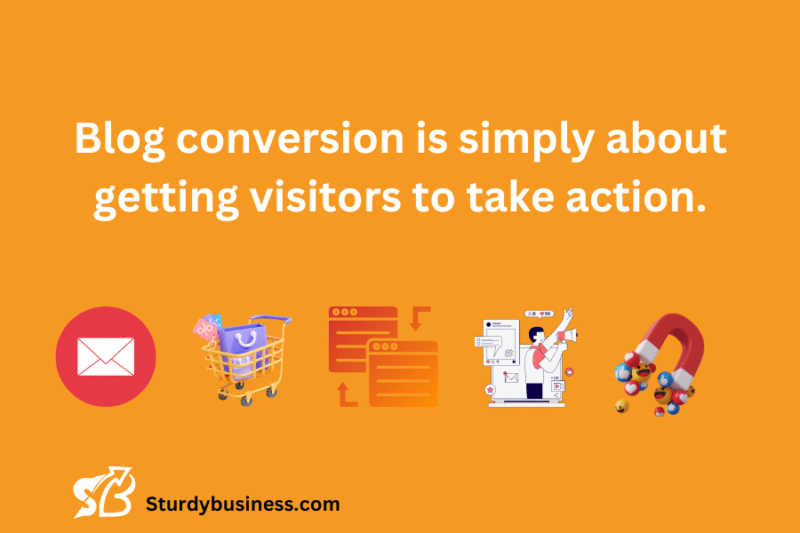
Blog conversion is simply about getting visitors to take action. This action can result in various outcomes, such as subscribing to your list, purchasing a subscription, redirecting to another site, or engaging in any other desired behavior.
For instance, in the context of SaaS businesses, the primary focus is often on generating leads or encouraging users to try out their products.
In the case of B2B blogs, the focus shifts towards convincing readers to not only explore but also make purchases of their products and services, and sometimes scheduling a discovery call.
The diverse nature of blog goals is clear, and it is essential to align them with specific outcomes.
For example, a blog post explaining the principles of content marketing may not directly translate into immediate sales. However, crafting a post that highlights the best content marketing tools could potentially drive readers to sign up for a particular product.
Therefore, each blog post should have a clear goal that determines the kinds of offers and actions made.
Ordinarily, four types of conversions are emphasized by most businesses:
- Email lists building or gaining subscribers. The money is in the list, all digital marketers say.
- Getting leads.
- Getting people to sign up for products or request sales demos.
- Redirecting them to other websites.
Now, let’s understand why it’s important to invest time in optimizing your content for conversions and how many extra dollars you can expect.
How many blog conversions must you be getting?
First of all, let me ask, what’s your blog conversion ratio?
It’s important to know how much you are already converting so that you can compare it with the ideal conversion ratio that businesses often achieve.
A good conversion rate for a blog is typically between 2% and 5%. This means that at least two to five people out of every 100 visitors will take the action the blog owner intended, such as filling out a form, making a purchase or scheduling a call.
However, it’s essential to note that this rate may vary for each blog. For instance, I had an average conversion rate of over 7% last year. And it can still be enhanced by improving UI/UX.
It also depends on the keywords you have targeted. If you have chosen valuable keywords, especially money keywords, then you can expect a conversion rate higher than the average.
Therefore, you should only consider the number to determine the minimum blog conversion you should be aiming for. Otherwise, the number doesn’t mean much; it indicates that you are closer to your target audience, meeting your goals, and ultimately reaching many people through your blog.
The closer you are to potential customers and the more you invest in building your brand, the better you can improve blog conversions.
7 ways to convert blog traffic into conversions:
Here are seven practical ways to convert your blog traffic into conversions.
Build page-level trust (PLT) for massive conversions.
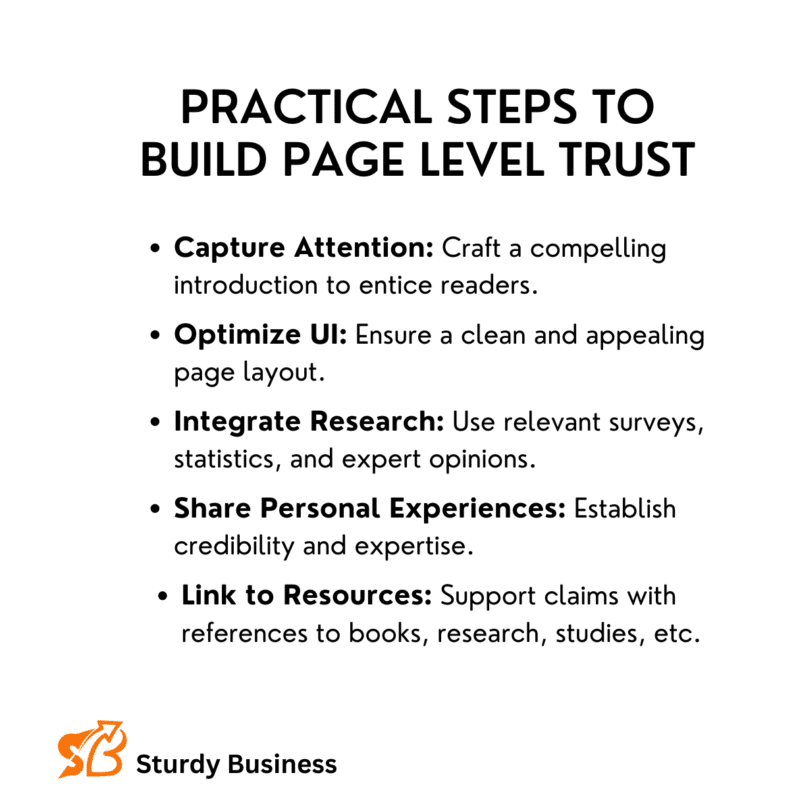
Typically, writing a how-to post can be done by many people but the difference you will make is doing much more. A little extra effort can help you build trust and boost your branding. Once you work on this, you are not just another blog; you sound like a top brand in your industry.
You should focus on building page level trust.
We can summarize it as:
You excel in every aspect of your webpage to build trust and authority, encouraging your audience to heed your call to action, which prompts them to submit their email addresses.
Here are some tips to build page-level trust on your blog:
- Capture the reader’s attention in the first few paragraphs. You can achieve this easily with a copywriter or copywriting skills. In one line, make the introduction persuasive enough to compel the reader to continue.
- Make sure the UI of the page is very clean and appealing.
- Conduct additional research to identify relevant surveys, statistics, and expert opinions, then integrate them into your blog.
- Infuse your personal experiences to establish credibility and convey your expertise in the field, making the reader believe in your authority on the subject.
- Support claims with references to books, research, studies, and experts’ opinions, etc.
This way, you can build trust, ultimately leading to the conversion of your blog traffic into leads and loyal customers.
For instance, consider this: the Sturdy Business team has gone a few steps further to find relevant industry data, add more value, create an infographic, and integrate it into the article to build page-level trust.
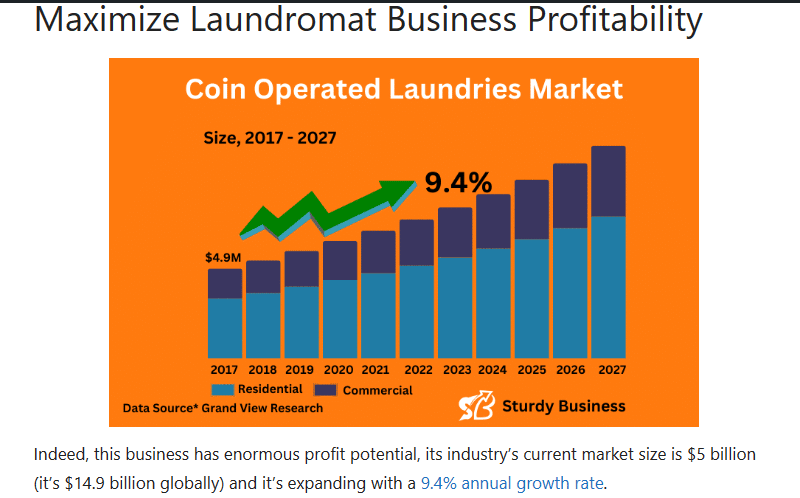
If you also focus on building page-level trust and your brand, you can surely experience a significant increase in conversions.
Improve the UI/UX:
Alex Hormozi, in his book “$100M Leads,” said, “People judge every book by its cover.”
On your blog, the cover is your website’s interface and user experience (UI/UX). You should always spend a lot of time improving your website’s first impressions on the user.
When your potential customers have landed on your landing page, they must be convinced and inspired by your website, and they should believe in you as a brand.
Having the best UI doesn’t mean making it a fancy site; it only means it should not look like just another blog. It can be simple and clean and yet leave a long-lasting impression on the user.
For instance, your logo, brand colors, graphics, testimonials, ratings, vocabulary, tone, and other visible information can also make you look like a brand.
Know your audience:
As I said earlier in the startup blog strategy, if you want to increase the conversions of your blog, you can’t do it without understanding your audience. You should spend a lot of time knowing your customers. What are their interests, pain points, and aspirations?
Once you have this data, you can integrate their interests, pain points, and inspirations into your articles and provide solutions to help them achieve their goals.
In this way, you can make them realize that you know them and you can help them.
So, guess what?
Yes, it will result in massive conversions.
It’s a no-brainer that creating content that specifically addresses what the audience wants, makes them more likely to convert and become loyal customers.
Here is how to know your audience.
Ask yourself:
1. Who are you writing for?
Don’t say ‘everybody,’ because that’s too broad. Successful bloggers target a specific group of people. Creating content that resonates with a particular group is easier if you have a niche, and this builds trust and increases conversions.
Be very specific about the problems you can solve, and think the audience which may be facing those issues. Now, you are way close to your audience.
2. What are their problems?
Knowing what your audience is struggling with is important if you want to create content that speaks directly to their needs.
For instance, in this article, I know that you are a business looking to convert traffic. If you don’t, you are wasting free opportunities to gain customers/sales.
Since I am familiar with the reasons why blog traffic often doesn’t convert, having faced these issues and resolved them on my clients’ business websites, I can guide you on how to address this problem.
I am here to make you aware that, in addition to my SEO skills, I am also an expert at conversions. You can anticipate a significant return on investment (ROI) by leveraging my SEO services.
Does this make sense?
Similarly, understanding your audience and making them aware that you have solutions to their problems makes it easier to convert them through your blog. They will trust the information from your blog as a reliable source and follow your words.
Here is another example: If you have a SaaS product, outline the solutions it provides to your customers. Also research, what is your unique selling proposition (USP)?
Now, explore the web to discover the relevant questions people are asking. You can employ easy keyword research strategies or search on QA platforms like Reddit and Quora.
Invest a huge time in identifying the challenges they face that can be addressed using your product or service.
Once you understand what your visitors require, position yourself as someone who solves their problems (as your SaaS does), increasing the likelihood of them making a purchase.
Always remember that you must have a solution to their problems, and never overpromise. Otherwise, it will result in a bad reputation that cannot be reversed.
Create content that helps the conversion.
It could be that the best way to turn blog traffic into conversions is by reviewing what you know about the target audience of your website. Usually, blogs do not convert because of these two main reasons:
- You didn’t target the right keywords.
- Your blog language and tone of voice do not resonate with your audience.
So, how can this be resolved?
You should begin with appropriate keyword research. Find keywords with buying intent (referred to as transactional keywords).
At the end of the day, these are the keywords that will generate revenue for you.
Write engaging, converting content based on these keywords. If you already have irrelevant pieces that have nothing to do with your blog goals, remove them and redirect them to relevant, valuable assets.
If you have already targeted the right keywords and satisfied the user intent, but it’s not converting, it’s time to edit your piece to make it more relevant to your audience.
In other words, understand the feelings, thoughts, attitudes, and behaviors of those who make up your audience in a deeper manner. And, by all means, be relevant to them in your blogs.
For instance: how they feel about something, what interests them in the text they read, or why they stay connected.
Here are some tips to make your content engaging and converting.
- Make your content easy to read.
- Use bold headings and subheadings.
- Keep sentences short (not more than 20 words).
- Keep paragraphs short
- Break up the text with images or screenshots.
- Use bullet points or numbered lists when needed
It will enable you to engage people longer on your page which will in turn increase conversion chances by making the content easily skimmable.
Similarly, if you want to do even deeper, you can utilize Google Analytics information, such as retention rates for different blog posts.
Create attention-grabbing CTAs
The way you direct your reader to act is very important for conversion rate optimization (CRO).
If the blog CTA has a 4-5% conversion rate, it’s quite normal. If you don’t hit that, however, it might be time to go back and examine your CTAs again.
The CTA must be distinct from the other content and have an obvious link shape.
It can get lost amidst the rest of the content when it becomes indistinctive. Placing an image or using a different color on your CTA will make it more conspicuous to readers.
A good CTA should be clear, captivating, and short; it also needs social proof in its body. However, ensure you are not being too cocky with this statement so that you may keep your word intact and provide what you promised while writing this text.
However, it has to be a complement that drives conversions, i.e., a little nudge that propels people toward making their final decisions.
Here is the best CTA example I have found in my recent research.
HubSpot is offering free CTA templates on a webpage that discusses call-to-action. This simply means that if someone wants to learn about CTAs, they can obtain CTA templates in exchange for providing an email address.
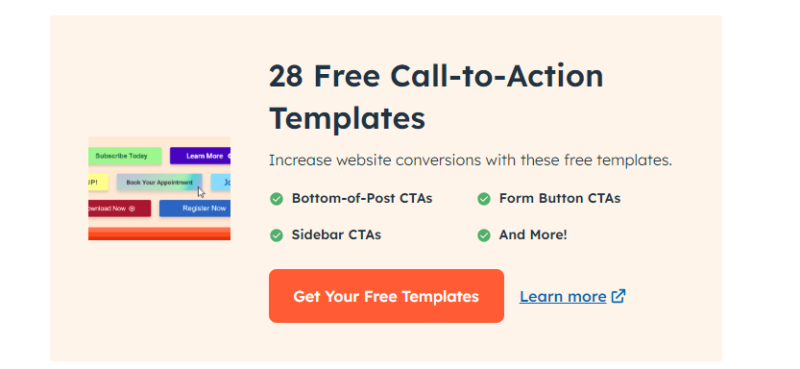
So, by doing this, you will have an email list that works well for nurturing leads.
Speed up your website for a high conversion rate.
I can’t stress this enough: make sure your website loads fast. Slow loading times make customers leave your website.
In fact,
Almost half of online users, precisely 47%, expect a webpage to complete loading within 2 seconds, as per Hubspot. And 55% of visitors leave it takes more than 3 seconds, google says.
Furthermore, a study conducted by mPulse Mobile, an AI healthcare tech company, revealed correlations between page load times and conversion rates:
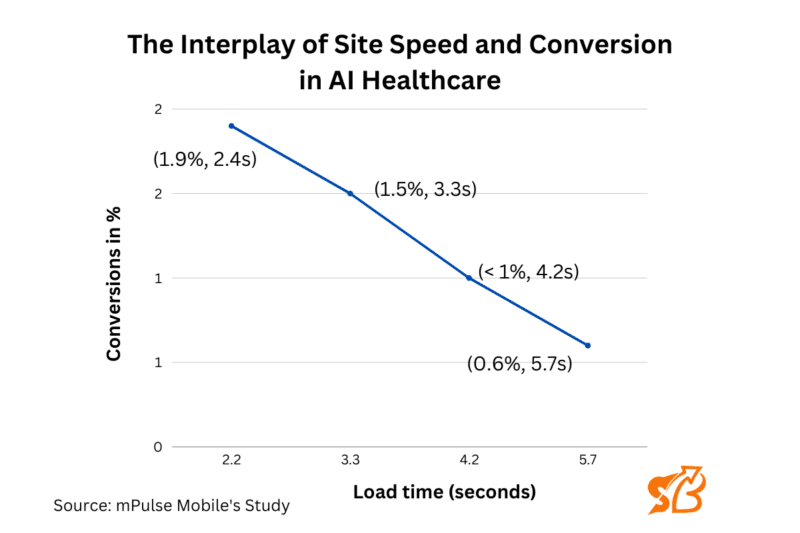
- Pages with a 2.4-second load time had a noteworthy 1.9% conversion rate.
- A slight delay to 3.3 seconds saw a dip in conversion rates to 1.5%.
- Once the load time extended to 4.2 seconds, the conversion rate plummeted to less than 1%. (That’s almost a 50% drop in conversions with a 1.8-second delay).
- Exceeding the 5.7-second mark resulted in a mere 0.6% conversion rate.
Here are some cool studies about loading times.
- Walmart.com saw a 2% increase in conversions for every second they improved load time
- Firefox made downloads increase by 15.4% by cutting load time by 2.2 seconds
- AutoAnything.com doubled their load speed and got 9% more conversions.
As you can see the speed of your website has a great impact on conversions. So, if you want to convert blog traffic to conversions, leads, or customers, it should be your top priority.
You can check how fast your blog loads using online tools like WebPageTest and Google Developers PageSpeed Tools.
If we check SturdyBusiness.com on Google page speed test, it loads in a just half a second.
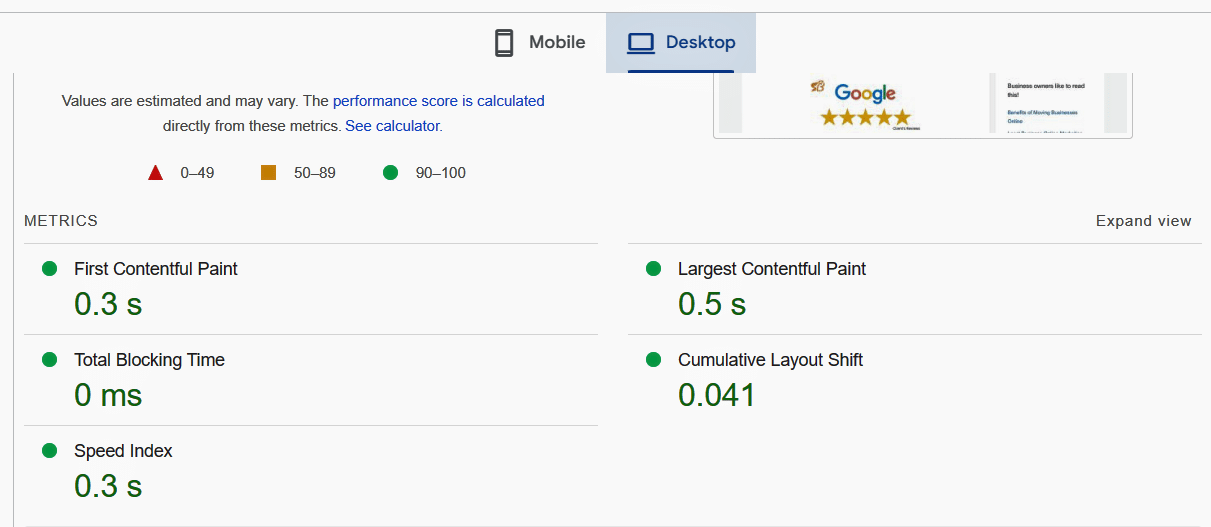
Here are some quick tips to improve your loading speed:
- Use fast hosting. I use Hostinger that’s the fastest and cheapest one.
- Employ a caching plugin.
- Optimize your images.
- Utilize Cloudflare.
- Avoid using resource-intensive plugins such as Elementor; instead, consider alternatives like GenerateBlocks within the GeneratePress framework.
- Implement manual coding whenever possible. Learning basic HTML and CSS allows you to replace many unnecessary plugins.
If you haven’t been implementing these tips already, incorporating them will lead to a faster site, resulting in improvements in conversions.
Offer something relevant for free.
This tool is often utilized by top industry leaders and brands to improve conversions.
If you can provide a valuable asset relevant to your webpage, you can ask for the email address in return. Whether it’s a how-to guide, a free template, a webinar, or anything that adds value to readers’ lives, it will result in a significant boost in conversions.
For instance, look at this, Hubspot is offering a relevant free webinar to convert blog traffic to conversions.

If you notice, it’s highly relevant, positioned at the most attention-grabbing spot.
You should also employ the same strategy to convert your blog traffic.